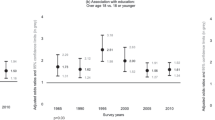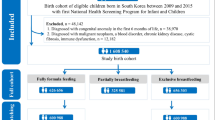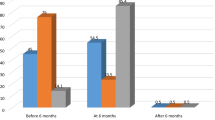Abstract
Objective:
To describe breastfeeding practices and to assess the sociodemographic factors associated with selected breastfeeding indicators.
Design and setting:
The 2003 Demographic and Health Survey was a multi-stage cluster sample survey of 4320 households from four different geographic areas in Timor-Leste.
Subjects:
A total of 2162 children aged 0–23 months.
Results:
A high proportion (97.6%) of infants had been ever breastfed, but only 46.1% had initiated breastfeeding within the first hour of birth. Seventy-eight percent of children <24 months were currently breastfed, 30.7% of infants <6 months were exclusively breastfed and 12.5% of infants <12 months were bottle-fed. A high proportion of infants of 6–9 months (82.0%) were receiving complementary food in addition to breast milk. Multivariate analysis revealed that exclusive breastfeeding was significantly lower in the rural west region (odds ratio (OR)=3.15) compared to the urban region, and among those from richest households (OR=1.90) compared to poorest. Mothers with primary education were significantly more likely to exclusively breastfeed than mothers with no education (OR=0.62). Increasing age of the infant was associated with significantly less current (OR=1.23) and exclusive (OR=1.35) breastfeeding. Continuation of breastfeeding at the end of the first year was significantly lower in non-working mothers (OR=1.58) compared to working mothers, and among infants born in health-care facilities (OR=2.16) than those born at home.
Conclusions:
Breastfeeding practices in Timor-Leste were satisfactory, except the exclusive breastfeeding at 6 months. However, more socioeconomically privileged groups demonstrated a poorer breastfeeding performance than disadvantaged groups. Further breastfeeding promotion programmes are needed across all population groups, and should include health-care providers and maternity institutions.
Sponsorship:
World Bank Trust Fund for East Timor.
This is a preview of subscription content, access via your institution
Access options
Subscribe to this journal
Receive 12 print issues and online access
$259.00 per year
only $21.58 per issue
Buy this article
- Purchase on Springer Link
- Instant access to full article PDF
Prices may be subject to local taxes which are calculated during checkout

Similar content being viewed by others
References
Aidam BA, Perez-Escamilla R, Lartey A, Aidam J (2005). Factors associated with exclusive breastfeeding in Accra, Ghana. Eur J Clin Nutr 59, 789–796.
Arifeen S, Black RE, Antelman G, Baqui A, Caulfield L, Becker S (2001a). Exclusive breastfeeding reduces acute respiratory infection and diarrhea deaths among infants in Dhaka slums. Pediatrics 108, e67.
Arifeen SE, Black RE, Caulfield LE, Antelman G, Baqui AH (2001b). Determinants of infant growth in the slums of Dhaka: size and maturity at birth, breastfeeding and morbidity, Eur. J Clin Nutr 55, 167–178.
Dewey K, Heinig MJ, Nommsen-Rivers L (1995). Differences in morbidity between breast-fed and formula-fed infants. J Pediatr 126, 696–702.
Dubois L, Girard M (2003). Social inequalities in infant feeding during the first year of life. The Longitudinal Study of Child Development in Quebec (LSCDQ 1998–2002). Public Health Nutr 6, 773–783.
El-Gilany AH (2003). Breasfeeding indicators in Dakahlia Governorate. Eastern Mediterr Health J 9, 961–973.
Filmer D, Pritchett L (1998). Estimating Wealth Effects without Expenditure Data or Tears: an Application to Educational Enrolments in States of India. Washington: World Bank Policy Research, 1998. Working Paper No. 1994.
Howie PW, Forsyth JS, Ogston SA, Clark A, Florey CD (1990). Protective effect of breast feeding against infection. BMJ 300, 11–16.
Jayathilaka CA, Fernando DN (2002). A community-based study on breastfeeding practices in Gampaha district. J College Commun Physicians Sri Lanka 7, 32–36.
Jones G, Steketee RW, Black RE, Bhutta ZA, Morris SS (2003). How many child deaths can we prevent this year? Lancet 362, 65–71.
Kelly YJ, Watt RG (2005). Breast-feeding initiation and exclusive duration at 6 months by social class – results from the Millennium Cohort Study. Public Health Nutr 8, 417–421.
Kumar S, Nath LM, Reddaiah VP (1989). Factors influencing prevalence of breastfeeding in a resettlement colony of New Delhi. Indian J Pediatr 56, 385–391.
Lakati A, Binns C, Stevenson M (2002). Breast-feeding and the working mother in Nairobi. Public Health Nutri 5, 715–718.
Lawoyin TO, Olawuyi JF, Onadeko MO (2001). Factors associated with exclusive breastfeeding in Ibadan, Nigeria. J Hum Lact 17, 321–325.
Li R, Darling N, Maurice E, Barker L, Grummer-Strawn LM (2005). Breastfeeding rates in the United States by characteristics of the child, mother, or family: The 2002 National Immunization Survey. Pediatrics 115, e31–e37.
Ministry of Health and National Statistics Office Timor-Leste, The Australian National University, University of Newcastle and ACIL Australia Pty Ltd (2004). Timor-Leste 2003 Demographic and Health Survey. University of Newcastle: Newcastle.
Richards M, Hardy R, Wadsworth ME (2002). Long-term effects of breast-feeding in a national birth cohort: educational attainment and midlife cognitive function. Public Health Nutr 5, 631–635.
Scott JA, Binns CW (1999). Factors associated with the initiation and duration of breastfeeding: a review of the literature. Breastfeed Rev 7, 5–16.
UNICEF (2005a). Childhood under threat: state of the world's children 2005.http://www.unicef.org/sowc05/english/statistics.html Accessed 15 August 2005.
UNICEF (2005b). UNICEF Statistics, Multiple Indicator Cluster Surveys (MICS): Assessing the Economic Status of households. http://www.childinfo.org/MICS2/finques/gj00106a.htm Accessed 02 May 2005.
World Health Organization (1991). Indicators for Assessing Breast-Feeding Practices: Report of an Informal Meeting. WHO: Geneva. WHO/CDD/SER/91.14.
World Health Organization (2002). Infant and Young Child Nutrition: Global Strategy on Infant and Young Child Feeding. WHO: Geneva. Resolution WHA55/15.
Wright AL, Holberg CJ, Martinez FD, Morgan WJ, Taussig LM (1989). Breast feeding and lower respiratory tract illness in the first year of life. BMJ 299, 946–949.
Yngve A, Söjström M (2001). Breastfeeding determinants and a suggested framework for action in Europe. Public Health Nutr 4, 729–739.
Acknowledgements
We acknowledge the World Bank Trust Fund for East Timor for funding the DHS survey and the University of Colombo, Sri Lanka for sponsoring a fellowship for the first author. We are also grateful to Professor Graham Vimpani, Clinical Chair of the Kaleidoscope in Greater Newcastle, for his support for this research activity.
Author information
Authors and Affiliations
Corresponding author
Additional information
Guarantor: MJ Dibley.
Rights and permissions
About this article
Cite this article
Senarath, U., Dibley, M. & Agho, K. Breastfeeding practices and associated factors among children under 24 months of age in Timor-Leste. Eur J Clin Nutr 61, 387–397 (2007). https://doi.org/10.1038/sj.ejcn.1602536
Received:
Revised:
Accepted:
Published:
Issue Date:
DOI: https://doi.org/10.1038/sj.ejcn.1602536
Keywords
This article is cited by
-
Associations between infant and young child feeding (IYCF) practice and attitudes toward intimate partner violence (IPV) in Timor-Leste
BMC Women's Health (2023)
-
Factors associated with exclusive breastfeeding of children under six months of age in Cote d’Ivoire
International Breastfeeding Journal (2023)
-
Factors associated with the maintenance of breastfeeding for 6, 12, and 24 months in adolescent mothers
BMC Public Health (2018)
-
Breastfeeding practices and determinants of exclusive breastfeeding in a cross-sectional study at a child welfare clinic in Tema Manhean, Ghana
International Breastfeeding Journal (2018)
-
Breastfeeding performance in Afar regional state, northeastern Ethiopia: a cross sectional study
BMC Pediatrics (2018)



